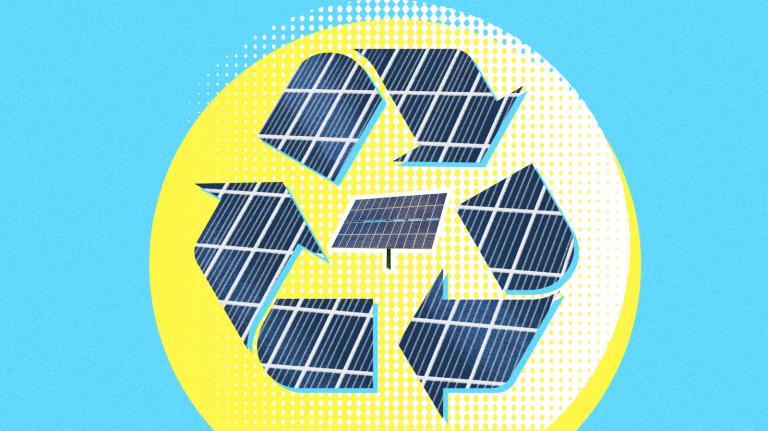Dear Umbra,
Why isn’t rooftop solar more highly touted as a climate change solution? I know it’s small scale, but it’s something that an individual person can actually DO. I love my solar panels, and I would like to see them on every flat surface that gets sunlight — schools, stores, churches, storage units, etc. Is it politics, economics, supply issues? It just seems so obvious to me!
— Solar Usage Needs Nurturing, Y’heard?
Dear SUNNY,
It might feel like solar panels have been around long enough that they should be plastering the built environment. After all, Jimmy Carter first put panels on the White House roof more than 40 years ago. But your vision of solar utopia may be a little ahead of the times. “Solar has only really been this economic for about five years,” Jenny Chase, the head of solar analysis at the energy research firm BloombergNEF, told me. Major home renovations don’t happen overnight.
Chase said that since 2004, when rooftop solar first started to take off in Germany, the cost of a solar module on the world market has declined from $4 per watt down to just $0.24 today. And considering how recently the cost came down, rooftop solar is bigger than you might think. Installations around the world have increased by an average of 25 percent per year. The U.S. has about 2.8 million installations, with more than a million in California, where rooftop solar supplies about 10 percent of the state’s electricity. And these numbers are growing fast. Even though the clean energy industry ground to a halt at the start of the COVID-19 pandemic, 2020 saw a record high in new rooftop solar capacity.
But despite amazing cost declines over the past decade, it’s still a major investment. Though total costs depend on the size of your home and which subsidies and loan programs are available in your area, the sticker price of an average-sized home installation in the U.S. is about $20,000, according to the Solar Energy Industry Association.
The truth is, SUNNY, rooftop solar is growing fast, but it’s not growing at the same pace everywhere, and it’s not as accessible to everyone as it may have been to you.
To start, let’s talk about your initial question. Why doesn’t rooftop solar get more attention as a climate solution? One reason policy experts tend to downplay rooftop solar is that it typically costs a lot more to install a handful of panels on a million roofs than to plant a vast crop of them across a field or a vacant lot. The National Renewable Energy Laboratory estimates that installing rooftop solar can cost nearly three times as much, per watt, as a big utility-scale project.
But that kind of thinking ignores a number of advantages of rooftop solar, like the fact that it doesn’t increase competition for land or threaten ecosystems. Putting panels on roofs can create more local jobs and economic development than big projects. When combined with batteries, they can provide a household with backup power when the grid goes down. A recent analysis by consulting firm Vibrant Clean Energy has even challenged the conventional wisdom that large-scale solar is cheaper. It found that deploying lots of rooftop solar, about 13 times as much as the U.S. has today, by 2050, combined with more battery storage systems, could save Americans hundreds of billions of dollars on electricity in the long run because of the services these distributed sources of energy provide to the grid.
I asked Chase, who spends her life thinking about these kinds of trade-offs, if she thought it made sense to put solar on everything, as you suggest, and she said yes. “Frankly, solar panels themselves are so cheap these days, I don’t think it makes much sense to build a roof without them, if that roof is even vaguely facing the sun,” she said.
Even though the panels themselves are so cheap, installation costs can vary widely. Chase said it’s far more expensive to put solar on your roof in the U.S. than in the rest of the world. That’s in part thanks to former President Donald Trump, who imposed steep import tariffs on solar panels. But the biggest source of that disparity is what are known as “soft costs” — the cost of administrative time sucks like getting the right permits.
I spoke to Anne Hoskins, the chief policy officer at Sunrun, which is the largest solar installer in the U.S. She said that permitting is a major obstacle for the company — it has to navigate the individual permitting requirements of thousands of local governments around the country. “It adds time, it adds cost, and just adds what we refer to as friction,” she said.
There may be some progress made on this front soon. The National Renewable Energy Laboratory recently released a piece of software called SolarApp that local governments can adopt that would help standardize permitting and automate much of the process of getting rooftop solar approved.
Electric utilities have also acted as obstacles to making rooftop solar more affordable and accessible. Chase explained that even though the panels themselves have grown cheap, what makes an investment in rooftop solar economical is the money a household can earn by sending its excess power back to the larger grid. In the U.S., many states require utilities to buy power from their customers that have rooftop solar, but levels of compensation vary, and there are a few states where rooftop solar owners aren’t compensated at all. Many utilities have also required that homeowners get expensive insurance policies or imposed fees that make the investment less attractive.
“In many places, the utility companies aren’t big fans of rooftop solar, because they perceive this as reducing their revenue,” said Warren Leon, executive director of the Clean Energy States Alliance, a nonprofit coalition of public agencies and organizations that work to advance clean energy. Utilities and their trade associations have been fighting policies and incentives that encourage rooftop solar for years.
Hoskins of Sunrun said there’s wide variation around the country in how long it takes utilities to connect a new rooftop solar system to the grid. Another issue arises when customers who have older houses want to install battery storage systems in addition to solar panels. They’ll often need to get an electrical upgrade from the utility, which she said can take a frustrating amount of time.
All these little delays add to those “soft costs” I mentioned earlier, jacking up the amount of money you have to be willing and able to throw down to get a solar system installed. And not everyone has several thousand dollars lying around to put toward the cause, even if they’re confident they’ll make the money back in the span of a few years. There are well-documented disparities in solar uptake by income level. Instead of asking why there isn’t more rooftop solar around, you might want to ask a slightly different version of the question: Why is rooftop solar so inaccessible to so many people?
One way around the large down payment is to lease a solar system. Companies like Sunrun offer leasing agreements where they own the panels and collect monthly fees, but customers still benefit from cheaper electricity. Leases don’t work for everyone, though. People who plan to sell their homes may not want to sign a 20-year agreement that they could end up on the hook for if the buyer isn’t interested in taking it over.
But I should say that cost isn’t the only factor holding people back. Personally, I’d love to put solar panels on my roof, but even if I could afford it, I wouldn’t be able to. Like more than a third of American households, I do not own my home. And since my landlord isn’t paying my energy bill, he has no financial incentive to invest in solar.
There are some state programs that help incentivize landlords to put rooftop solar on big multifamily apartment buildings, but rented single-family homes are trickier to target. Chase said she likes California’s solar mandate, which requires solar to be installed on all new buildings and during major renovations, as one solution.
Rooftop solar also has a whiteness problem. In 2019, researchers from the University of California, Berkeley, found that Black and Hispanic-majority census tracts have significantly less solar, even after accounting for income levels and homeownership. The authors write that there is a lack of initial deployment, or “seeding,” in these communities, and also suggest the disparity could be due to low diversity in the solar workforce.
So as you can see, SUNNY, there are plenty of obstacles to your vision of a world covered in solar panels. But the good news is that in addition to installing your own rooftop panels, there is something else you can actually DO — become a solar influencer!
Kimberly Wolske, assistant professor at the University of Chicago’s Harris School of Public Policy, researches what motivates people to adopt rooftop solar. And while early customers such as yourself may have gotten on board for environmental reasons or because they were excited about the technology, Wolske has found that now social influence is also a significant factor. When people either see solar roofs in their community, or talk to friends and neighbors that have them, they might become more interested, but more than that, it can assuage any concerns they have about the cost or the risk involved.
“It really is about reducing the perceived risk of making this investment on what is probably your single biggest investment — your home,” said Wolske.
Unfortunately, that social effect goes both ways. My mother, who lives in New Jersey, became interested in rooftop solar after she found out about state incentives through a neighbor. But that neighbor ended up having a hellish experience, with the installation leading to roof damage and leaks. Now it seems there’s nothing that could convince my mom to go for it. Maybe I’ll have her give you a call.




